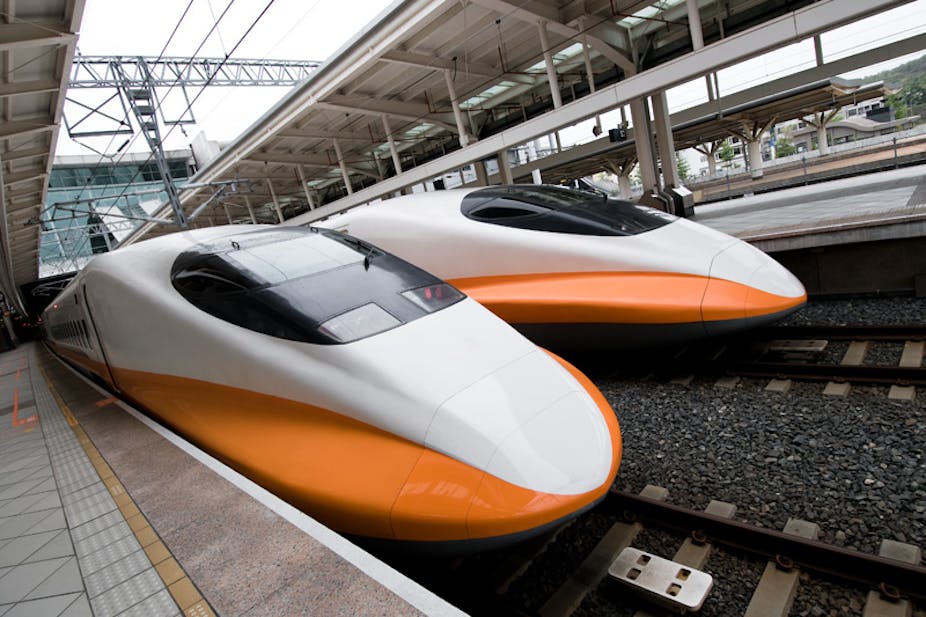The last half century has seen the gradual development of high-speed rail (HSR) systems. From the inauguration of the first “bullet train” services in Japan in 1964 to the recent rapid developments in China, the technology is triggering massive interest.
Evaluating whether HSR could be successfully developed can be simplified in two rules. High-speed rail services are suitable within a region that has large cities 100-500km apart, provided they are sufficiently populous and well connected. And there should already be existing short-haul air services between cities, as this demonstrates that a market for passengers that value high-speed travel exists.
Asia: high density, high potential
Asia is the most suitable candidate for HSR systems, with many cities densely populated to well above 5,000 people per square kilometre. Japan was the innovator, where the Shinkansen is a nationwide, integrated HSR system running on dedicated lines that services the major cities and three of the four main islands of the Japanese territory.

Both South Korea’s Korea Train Express (KTX) and Taiwan’s High Speed Rail services link their two largest cities. China has embarked on an ambitious plan to build a national HSR system that is showing a growing level of integration. Chinese HSR has grown rapidly and is already the world’s most extensive, with 9,700 km being operational as of 2013. It includes the world’s longest HSR service, linking Beijing and Guangzhou in approximately eight hours, which was inaugurated in December 2012. It is expected that by 2020, China’s HSR system will total 16,000 km.
For China the development of HSR was seen as a national priority because of the growing demands of an increasingly mobile population, the lack of transport infrastructure, and highly congested standard rail and air transport routes. India has several high speed corridors planned, but high capital requirements and securing rights of way are serious challenges.
Europe: connectivity at a cost
In Europe, the population of urban areas is lower, with cities generally above 3,000 people per square kilometre. Development of HSR has gradually permitted greater integration levels, particularly between the highly connected metropolitan areas of France, Belgium, the Netherlands and Germany.
France’s TGV (“train à grande vitesse”) became the byword for high speed European services with the launch of the Paris-Lyon in 1981, supplementing a Paris-Toulouse high speed service (200 km/h) that was operating since 1967. Italy was another early adopter with a high speed Rome-Florence service from 1977, and later pioneered the pendolino tilting-train technology, now used in trains all over the world, that allows trains to take turns at far higher speeds than otherwise possible.
High-speed rail arrived later in Spain with the Madrid-Seville line in 1992, but since 2005 the government has built Europe’s most extensive network, linking all major regional cities to the capital with high speed AVE trains.“

The completion of the Channel Tunnel in 1994 connected Britain to the continent’s rail systems, via the high speed Channel Tunnel Rail Link (now known as High Speed 1) between London St Pancras and the Folkestone terminus of the tunnel. The Scandinavian countries of Norway, Sweden and Finland have largely integrated HSR into their existing network by converting existing lines, reflecting the relatively short distances involved, smaller cities and lower population densities. As the 6,600km of European rail system grows more integrated, HSR hubs that connect different corridors are emerging, notably Brussels.
North America: postponed dreams
In North America, such is the vast size of the continent that, despite boasting some of the world’s largest cities, population density is low – commonly below 2,000 people per square kilometre. The only HSR service is Amtrak’s Acela Express that runs between Boston-New York-Philadelphia-Washington DC, but technical requirements limit the speed along several segments (the New York-Washington DC segment can be considered high speed).

Developing HSR corridors to link the regional cities of the US has been debated for more than 20 years, with many corridor projects clearly identified and advocated – for example San Francisco-San Diego, Quebec-Toronto, Miami-Orlando-Tampa or Vancouver-Seattle-Eugene. Yet the extent, prominence and relatively low cost of road and air transport have been played against the costs of building new rail.
The density of North American urban areas, including their city centres, is low enough to challenge the justification for large-scale HSR projects. Another barrier to HSR in North America is that private freight companies own and operate the majority of the rail network. This leads to right of way conflicts between existing freight trains and any potentially rising numbers of passenger trains in the vicinity of major metropolitan areas, which are also the sites of important cargo terminal facilities.
To subsidise, or not to subsidise
The problem is to reconcile this regional demand with high unrecoverable costs that are inevitably incurred building and operating HSR systems. So far HSR has not delivered financially sustainable systems. Only two individual lines are profitable: Paris-Lyon in France and Tokyo-Osaka in Japan – but not the rest of the networks they are part of.
So the majority of HSR lines depend on large subsidies from both taxpayers and other cross-subsidies. An infrastructure project cannot be judged a failure if there is still an ongoing willingness by society to cover operational costs and finance expansion. What matters is to ensure this cost is acceptable, since once the commitment is made there are limited alternatives to developing an HSR network to its fullest possible extent.
The dream of HSR services promoted by its supporters is of interconnected cities between which passengers can move with little effort and in an energy efficient manner. But the costs of this aspiration are very high and the benefits are rarely financial. And it is this, especially in these straightened times, that has prevented HSR from finding greater success around the world.

